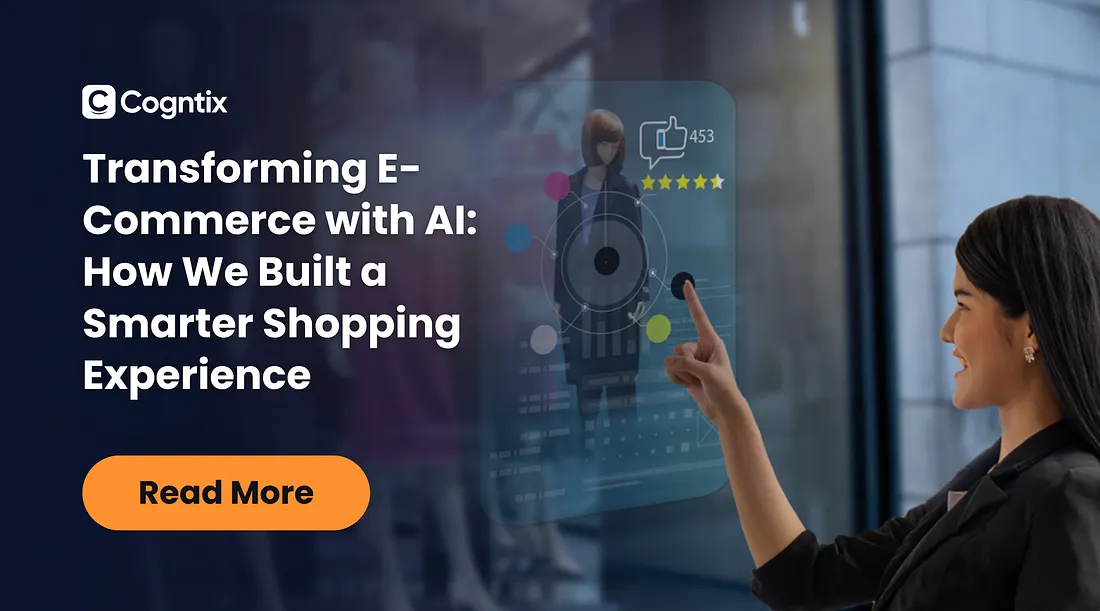E-commerce is more than just selling products — it’s about keeping customers engaged, personalizing their journey, and making sure they complete their purchase. But for many online retailers, that’s where the challenge begins.
One of our e-commerce clients, a fast-growing retail platform, was struggling with high bounce rates, low conversions, and frustrated customers who couldn’t find what they were looking for. Their customer support team was overwhelmed, and their product recommendations felt random rather than relevant.
They needed AI-powered personalization and automation to turn casual visitors into loyal buyers. That’s where we stepped in.
Where the Problem Started?
Like many e-commerce brands, our client had invested in ads, SEO, and social media marketing to drive traffic. But once users landed on their site:
Customers browsed, got frustrated, and left without purchasing.
Many users added items but never checked out.
Long response times led to lost sales.
Users struggled to find what they wanted.
They knew they needed a better shopping experience, but manual interventions weren’t scalable. That’s where AI came in.
How We Used AI to Solve These Challenges?
Instead of guessing what customers wanted, we built an AI-driven system that learned from every interaction — making shopping easier, more personalized, and more engaging.
1. AI Chatbots for 24/7 Support
Customers hate waiting for answers. Delayed responses = lost sales. We implemented an AI-powered chatbot using GPT-based models and NLP frameworks like spaCy to:
Answer product queries instantly — no need to wait for a human rep.
Guide users through the shopping process, from browsing to checkout.
Handle returns, shipping questions, and FAQs automatically.
Escalate complex issues only when needed, reducing support overload.
Sephora uses IBM Watson to power its Sephora Virtual Artist chatbot, which helps customers with queries and lets them try virtual makeup and skincare products using AR. It also offers product recommendations based on user behavior. This AI handles over 30% of customer service requests, reducing the need for human agents and enhancing the customer experience.
In our project, we implemented a similar chatbot, cutting support tickets by 30%, improving customer satisfaction by 20%, and reducing cart abandonment by providing real-time help to over 200,000 monthly visitors.
2. Personalized Product Recommendations That Work
Most e-commerce sites show generic recommendations, leading to irrelevant suggestions and lost sales. We implemented a data-driven recommendation engine powered by collaborative filtering and real-time behavior tracking.
Instead of random product suggestions, our AI analyzed:
What has the customer searched for before?
What do similar users buy?
What’s in their cart or wishlist right now?
Amazon uses collaborative filtering to personalize product recommendations based on a customer’s past purchases, browsing history, and what similar customers have bought. This system drives 35% of Amazon’s sales, boosting repeat business and order value. It also adapts recommendations for seasonal demand.
In our project, using collaborative filtering and TensorFlow, we increased our client’s conversion rate by 15% and average order value by 20%. For example, users searching for audio products like wireless headphones received tailored recommendations for compatible accessories, leading to better engagement and higher sales.
3. Smarter Search and Dynamic Pricing
Search should feel intuitive, but many customers struggle to find what they’re looking for. We revamped our client’s on-site search experience with AI-powered autocomplete, typo correction, and intent-based search.
AI understands “sneakers” and “running shoes” as the same.
AI prioritizes popular searches based on real-time demand.
Before the user finishes typing, the right products appear.
Additionally, we introduced dynamic pricing models using real-time demand forecasting. AI adjusted product prices based on:
Discounting only for users who hesitated at checkout.
Preventing overstocking or underpricing fast-selling items.
Adjusting pricing for sales events and peak demand periods.
Uber adjusts its fares based on demand, traffic, and time of day. For example, during high-demand events like concerts or sports, prices increase to balance supply and demand, ensuring enough drivers are available. Airbnb also adjusts prices based on location, season, and local events, raising rates during holidays or popular events.
For our client, we used Elasticsearch, AWS Lambda, and AI-driven dynamic pricing, improving search accuracy by 35% and boosting conversion rates by 18%. During a recent home appliance promotion, AI dynamically adjusted prices, resulting in a 40% sales increase.
What’s Next? Scaling AI for Even More Growth
With AI-powered automation, our client transformed their e-commerce platform from a static storefront into a dynamic, intelligent shopping experience. Customers found what they needed faster, received personalized recommendations, and got instant support, all without overwhelming the business with manual work.
But this is just the beginning. E-commerce is evolving, and businesses that don’t leverage AI will struggle to keep up. The brands winning today aren’t just selling products, they’re delivering seamless, data-driven experiences that keep customers coming back.
At Cogntix, we specialize in AI-driven e-commerce solutions that boost engagement, conversions, and revenue. Whether you need smarter recommendations, AI-powered chatbots, or real-time pricing optimization, we can build it.
Let’s turn your e-commerce store into a high-converting, intelligent platform. Contact Cogntix today and start the transformation.
Written by: Gayathri Priya Krishnaram (Digital Content Writer at Cogntix)




